The global protein powder market was valued at a staggering $21.5 billion in 2022 and is expected to grow 6.5% annually between 2023 and 2032. With so much money on the line, it shouldn’t be surprising that many manufacturers use cheap ingredients to maximize profits.
As a result — and as I discuss in the video below — many of the protein powders available today are the equivalent of junk food because they contain unhealthy, inflammatory and ultra-processed ingredients such as artificial flavors, sweeteners and colors, binders and flow agents.
I began supplementing with protein powders in the late 1990s, a few years before I became a professional track athlete and the fifth-fastest European Junior sprinter. In this article, I’ll share the healthiest and most effective protein powders I’ve found.
Here’s a quick summary (scroll down to learn more about each):
- Best beef protein powder: Equip Prime Protein. It’s made with 100% grass-fed beef protein isolate, tastes delicious, and contains no funky ingredients. (It’s also available in an unflavored formula.)
- Best collagen protein powder: MK Supplements Collagen & Colostrum. This unique supplement contains a combination of grass-fed collagen protein and bovine colostrum to support optimal gut, joint, skin, nail and hair health.
- Best whey protein powder: B.Rad Whey Protein + Creatine. It offers high-quality, grass-fed whey protein isolate, which ensures optimal bioavailability and nutrient integrity. Additionally, the inclusion of creatine monohydrate enhances the supplement’s benefits, making it highly effective for improving exercise performance and recovery.
- Best for a carnivore diet: Noble Beef Protein. This is another clean beef protein isolate that tastes delicious. Noble includes bovine colostrum and freeze-dried beef organs, which provide pure nose-to-tail nutrition.
- Best for a keto diet: Perfect Keto Whey Protein. This whey protein isolate contains five grams of added medium-chain triglycerides (MCTs), which your body can convert into ketones. Paired with natural flavors made from dehydrated cocoa and vanilla beans, it’s the best choice for anyone who follows a low-carb diet.
One of the four options above should work for most people, but I’ve also identified a number of specialty products for those with specific needs or special dietary restrictions:
- Goat protein powder (it’s easy to digest and less allergenic than other options).
- Egg protein powder (it’s the best animal-based alternative to beef and dairy protein).
- Casein protein powder (the gut absorbs casein protein slowly, which some athletes prefer).
- Vegan protein powder (a reasonable product for those who can’t have animal-based protein).
I look for manufacturers that leverage gentle processing techniques (e.g., cold processing) and products with high-quality ingredients. For example, I look for beef and whey protein isolate (instead of concentrate) from grass-fed and pasture-raised animals.
I also ensure the products I choose don’t contain artificial colors, flavors and sweeteners (e.g., sucralose or Ace K). Instead, I stick to protein powders that contain natural sweeteners (e.g., small amounts of organic cane sugar, monk fruit or stevia) and natural flavors (ideally from dehydrated or evaporated whole food sources).
Best Beef Protein Powder: Equip Prime Protein
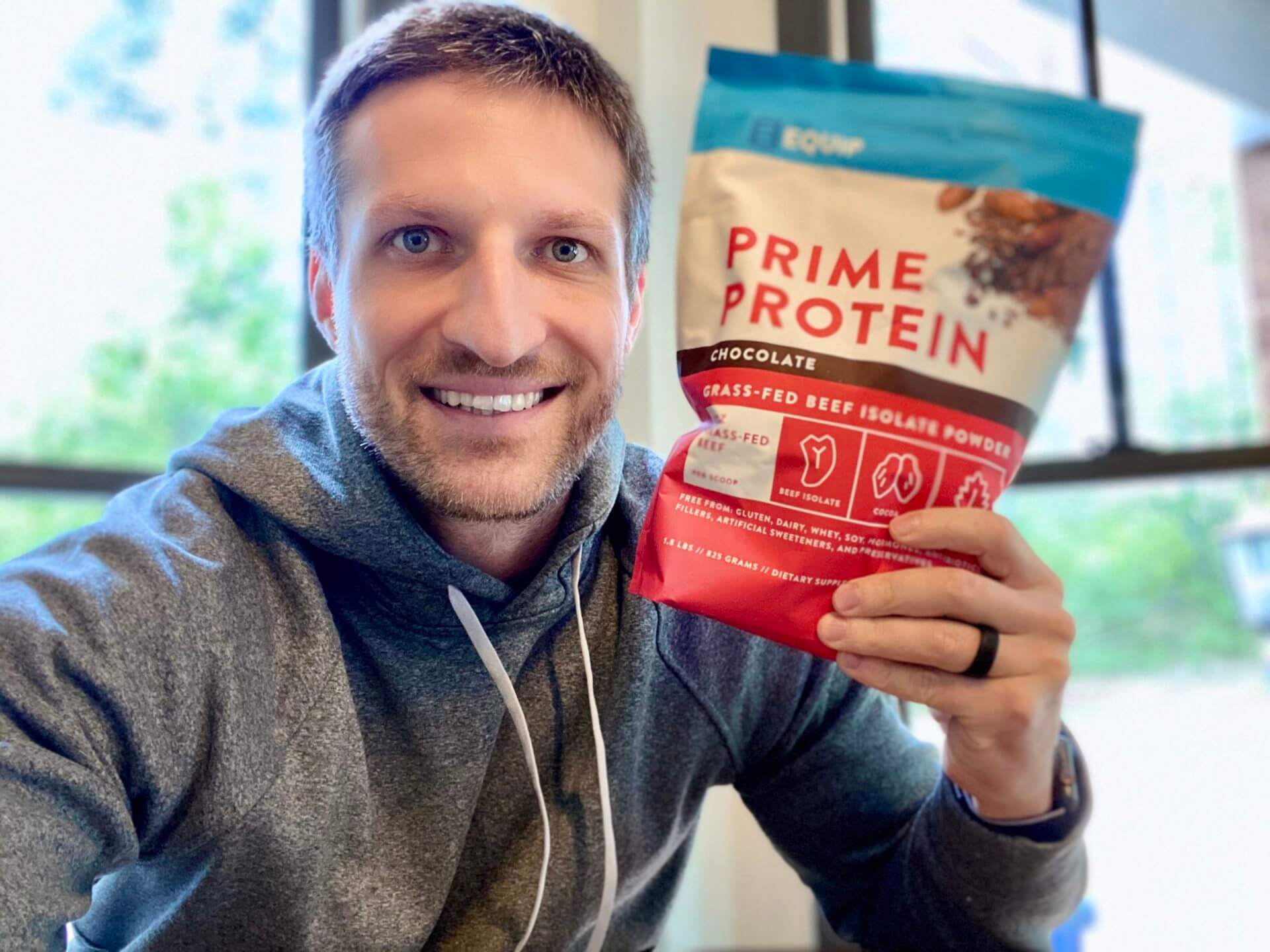
Equip Prime Protein is made entirely from grass-fed beef protein isolate, ensuring a natural and pure product without the harmful additives, fillers and flow agents often found in other products. While all the flavored versions of Prime Protein are delicious, purists can opt for an unflavored single-ingredient version that contains nothing but beef protein isolate.
| Cost per serving: | $2. |
| Protein per serving: | 21 grams. |
| Ingredients: | Grass-fed beef protein isolate, natural flavors (vary by flavor), sea salt (some of the flavors), acacia fiber (some of the flavors), stevia extract. |
| Notes: | Available unflavored or in six delicious flavors (chocolate, vanilla, salted caramel, peanut butter, strawberry, iced coffee). |
The bottom line is that Prime Protein is the cleanest beef protein powder on the market. It’s also arguably the best-tasting one, and I love using it to increase my daily protein intake. For these reasons, it ranked it #1 on my list of the beast beef protein powders.
Prime Protein mixes relatively well with both cold and hot liquids, including water and raw milk. But you’ll likely notice some clumping, considering that Equip doesn’t use any flow agents or emulsifiers in its product.
Our kids enjoy it with raw A2 milk that we source from a local farm. Adding milk makes the final shake thicker and creamier than when mixed with water, which they prefer. But if we run out of milk, we mix Prime Protein with cold or warm water.
I prefer mixing Prime Protein with raw milk kefir, which I make from scratch every other day. The kefir’s slightly tangy flavor blends well with Prime Protein’s natural flavors.
My wife uses Prime Protein to make smoothies by combining the powder with other powdered supplements, including a collagen peptide powder.
The only downside to Prime Protein is its cost of $63.99 per pouch.
Using my promo code (MK15) will get you 15% off. When combined with a subscription, that lowers the price per serving down to a very reasonable $1.69.
Check out my dedicated Equip Prime Protein review to learn more about this product.
Also Worth Considering: PaleoPro’s Paleo Protein Powder
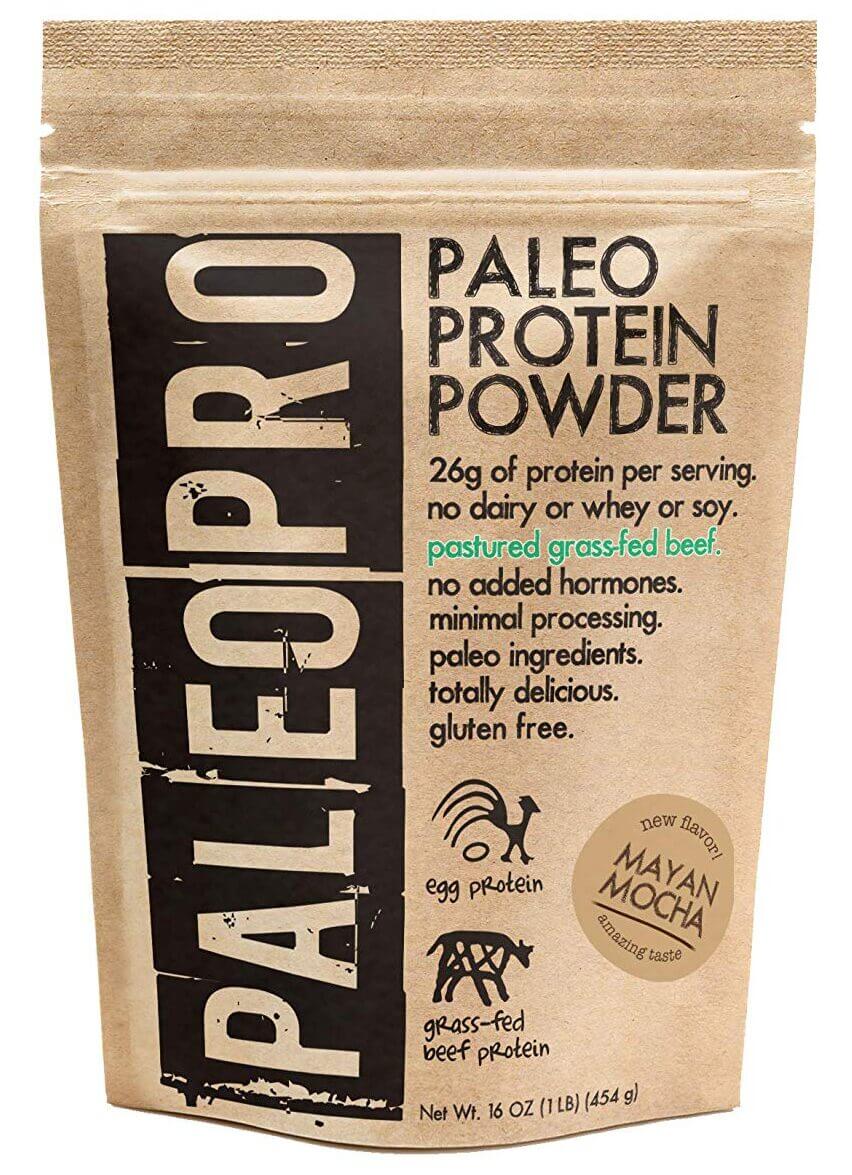
I learned about PaleoPro from an article in the now defunct Paleo Magazine. What caught my attention immediately was that this minimally-processed beef protein is specifically made for folks like me who follow a (generally) Paleolithic lifestyle.
For example, PaleoPro uses monk fruit extract, which some people prefer over stevia (including yours truly). While stevia is technically paleo, not everyone likes its taste, and it can be thought of as a lower-quality (cheaper) substitute for monk fruit.
On the other hand, although most of the protein in this product comes from pastured beef, it also has egg white protein from non-GMO and cage-free eggs. That’s a downside for all the reasons I discuss in this video about how unhealthy most chicken is.
PaleoPro is available unflavored or in four delicious flavors, including Aztec Vanilla, Ancient Cacao, Mayan Mocha and Mocha Mint. Each pouch contains 15 servings and delivers 26 grams of protein per serving.
Best Collagen Protein Powder: MK Supplements Collagen & Colostrum

My wife Kathy and I are big fans of both collagen protein and bovine colostrum, due to their respective benefits for gut, skin, hair, nail and joint health. Given how well the two ingredients complement each other, we decided to combine them in a single supplement and add it to the MK Supplements product line.
The unflavored version of our Collagen & Colostrum powder contains only two ingredients: 10 grams of hydrolyzed collagen peptides and 3 grams of bovine colostrum from grass-fed cattle. (The chocolate version also contains cocoa powder and monk fruit.)
The main advantage of using hydrolyzed collagen is that the body can rearrange the individual peptides into any type of collagen it requires to build joint, skin, muscle, nail or bone tissue. That’s much more effective than consuming specific types of collagen (or a multi-collagen).
Another unique benefit of our Collagen & Colostrum supplement is that the colostrum is harvested within the first 24 hours of the cow delivering the calf. That ensures high concentrations of all the beneficial immune factors. (Of course, modern dairy cows are bred to produce significantly more colostrum, transitional and regular milk than the calf can drink. So, the ranchers we work with allow the calf get first dibs before harvesting the leftovers.)
| Cost per serving: | $2. |
| Protein per serving: | 10 grams (from collagen and colostrum). |
| Ingredients: | Grass-fed hydrolyzed collagen peptides, grass-fed bovine colostrum. |
| Notes: | The collagen dissolves completely in hot or cold liquids. The colostrum mixes well, but it doesn’t dissolve entirely due to its residual fat content. |
While we initially developed Collagen & Colostrum to support our customers who have gut issues — because both collagen and colostrum are excellent supplements for repairing the delicate lining inside the gut — it’s also an excellent option for improving bone, joint and muscle strength. My wife and I take Collagen & Colostrum daily as part of our post-workout shake by mixing it with raw milk or homemade kefir.
You can also get Collagen & Colostrum via our Amazon storefront.
Best Whey Protein Powder: B.Rad Whey Protein + Creatine
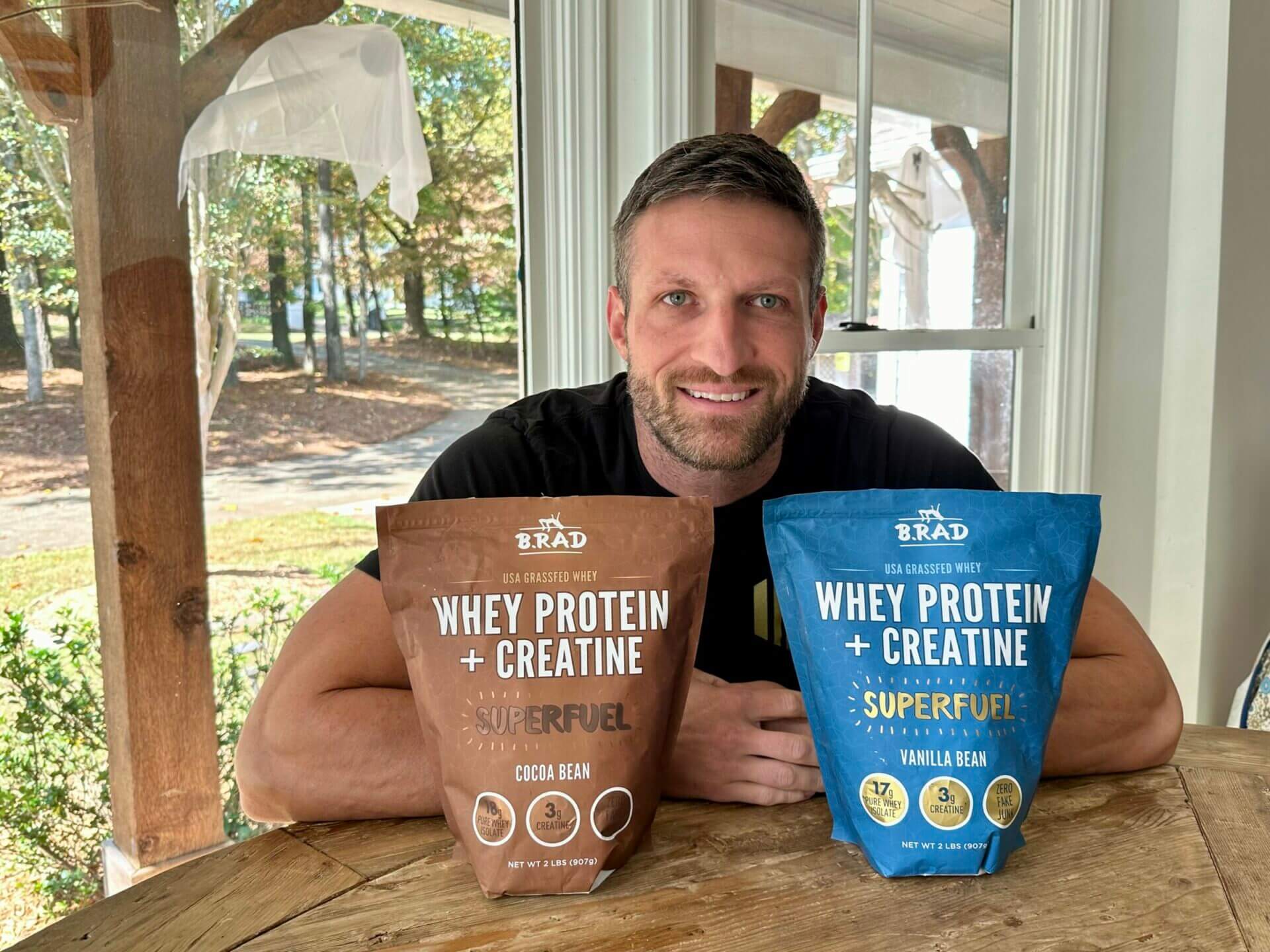
B.Rad’s whey protein powder is made from the milk of dairy cows raised on small family farms in Wisconsin, a key differentiator from most other whey protein powders on the market (which often use milk from factory-farmed cows raised all over the world).
Just as importantly, the product is made from whey protein isolate as opposed to the less pure whey protein concentrate. For context, whey protein isolate is 90-95% pure, whereas whey protein concentrate is only about 70-85% pure. The latter also contains residual fat and lactose, which can cause digestive issues in people who are lactose-intolerant.
Another unique selling point of B.Rad’s whey protein is that each serving contains three grams of creatine monohydrate, which is one of the most-studied supplements in the context of improving athletic performance. I’m a huge fan of creatine and consume it daily to improve my exercise performance and recovery.
| Cost per serving: | $2. |
| Protein per serving: | 17 to 18 grams. |
| Ingredients: | Grass-fed whey protein isolate, creatine monohydrate, natural flavors (South American cocoa bean or Madagascar vanilla bean), organic cane sugar or stevia extract (depending on flavor), traces of sunflower lecithin. |
| Notes: | The vanilla version has four grams of organic cane sugar per serving, while the cocoa bean flavor uses stevia as a non-caloric sweetener. |
If you’re a fan of rich chocolate or vanilla flavors, this clean whey protein powder might disappoint you because the flavors are much more subtle than those of other protein powders in this roundup.
Both B.Rad flavors taste delicious when mixed with raw milk. But if you’re not a fan of milk (or don’t have access to raw milk), B.Rad Whey Protein + Creatine also tastes delicious when mixed with filtered water. That said, it’s slightly less rich and creamy compared to when mixed with full-fat milk, as you might expect.
Overall, I consider B.Rad Whey Protein + Creatine an excellent choice if you appreciate the high bioavailability of whey protein isolate. Additionally, the three grams of added creatine per serving offer an easy way to improve athletic performance and facilitate post-workout recovery.
If you purchase directly from the B.Rad website, you can use the promo code KUMMER to get 10% off your purchase of both single bags and their “Buy 3, Get 1 Free” deal.
Check out my dedicated B.Rad Grass-Fed Whey Protein + Creatine Superfuel review to learn more.
Also Worth Considering: Naked Nutrition’s Naked Whey
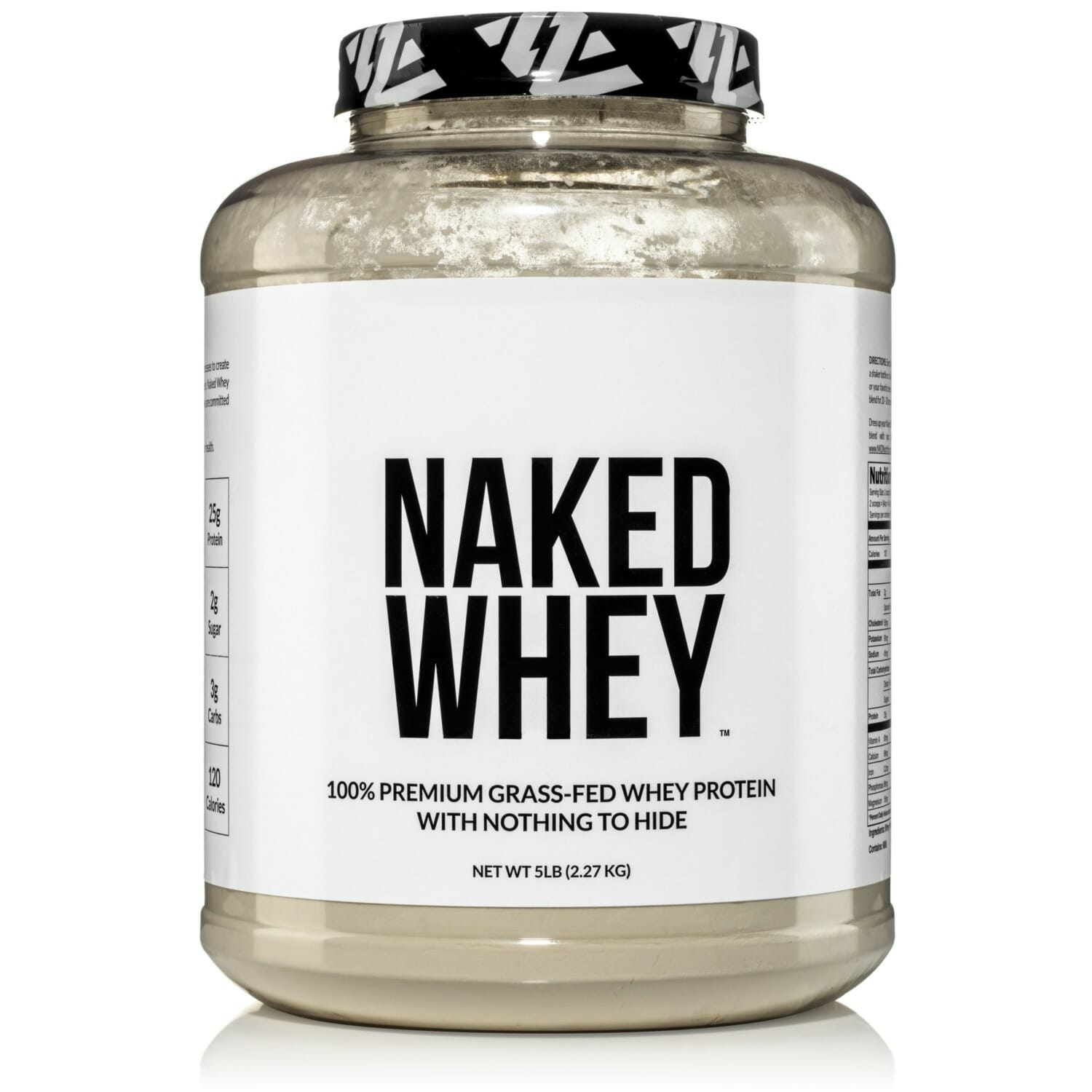
The unflavored version of Naked Nutrition’s grass-fed whey protein has a neutral flavor and a single ingredient: carefully-processed, unflavored grass-fed whey protein concentrate, with a fantastic amino acid profile. If you’re looking for the “cleanest” possible product, that gives it a leg up on B.Rad’s.
On the other hand, the main downside of Naked Whey is that it contains whey protein concentrate instead of isolate. The former has more impurities and may contain trace amounts of lactose and fats, which could be a trigger in people with sensitivities.
To maximize the nutritional value of its protein, Naked Nutrition uses a low-heat processing method that doesn’t require acid or bleach. What I like about Naked Nutrition’s product is the cost per serving, as well as the fact that even the company’s flavored (i.e., less “naked”) formulas don’t contain any unhealthy ingredients.
Best for a Carnivore Diet: Noble Beef Protein

Noble is a nose-to-tail protein powder made with beef protein isolate, freeze-dried beef organs, collagen and colostrum. While it certainly isn’t the lowest-cost option on the market, I appreciate its great taste, good mixability and best-in-class ingredient profile.
In addition to 21 grams of beef protein isolate, each serving delivers 250 mg of beef organs and colostrum. The former is a rich source of bioavailable and readily absorbable micronutrients, including vitamins, minerals and enzymes. The latter includes growth factors and other micronutrients to support your immune system and gut health.
(Learn more about the health benefits of eating organ meat and supplementing with colostrum.)
| Cost per serving: | $2.63. |
| Protein per serving: | 21 grams. |
| Ingredients: | Grass-fed beef protein isolate, nose-to-tail organ blend, Himalayan rock salt, xanthan gum, stevia and natural flavors (chocolate or vanilla). |
| Notes | Noble Beef Protein is available in two delicious flavors: chocolate and vanilla. |
Frankly, I’m often the only one in the Kummer household who loves how a supplement or protein powder tastes; more often than not, my wife and kids don’t share my opinion. With Noble, it’s different. Everyone loves it, including our picky eight-year-old.
As of this writing, we all consume a scoop of Noble Beef Protein (chocolate flavor) daily with breakfast. My wife, daughter and son mix it with raw milk, and I add a scoop to my daily jar of raw milk kefir (see the photo below).
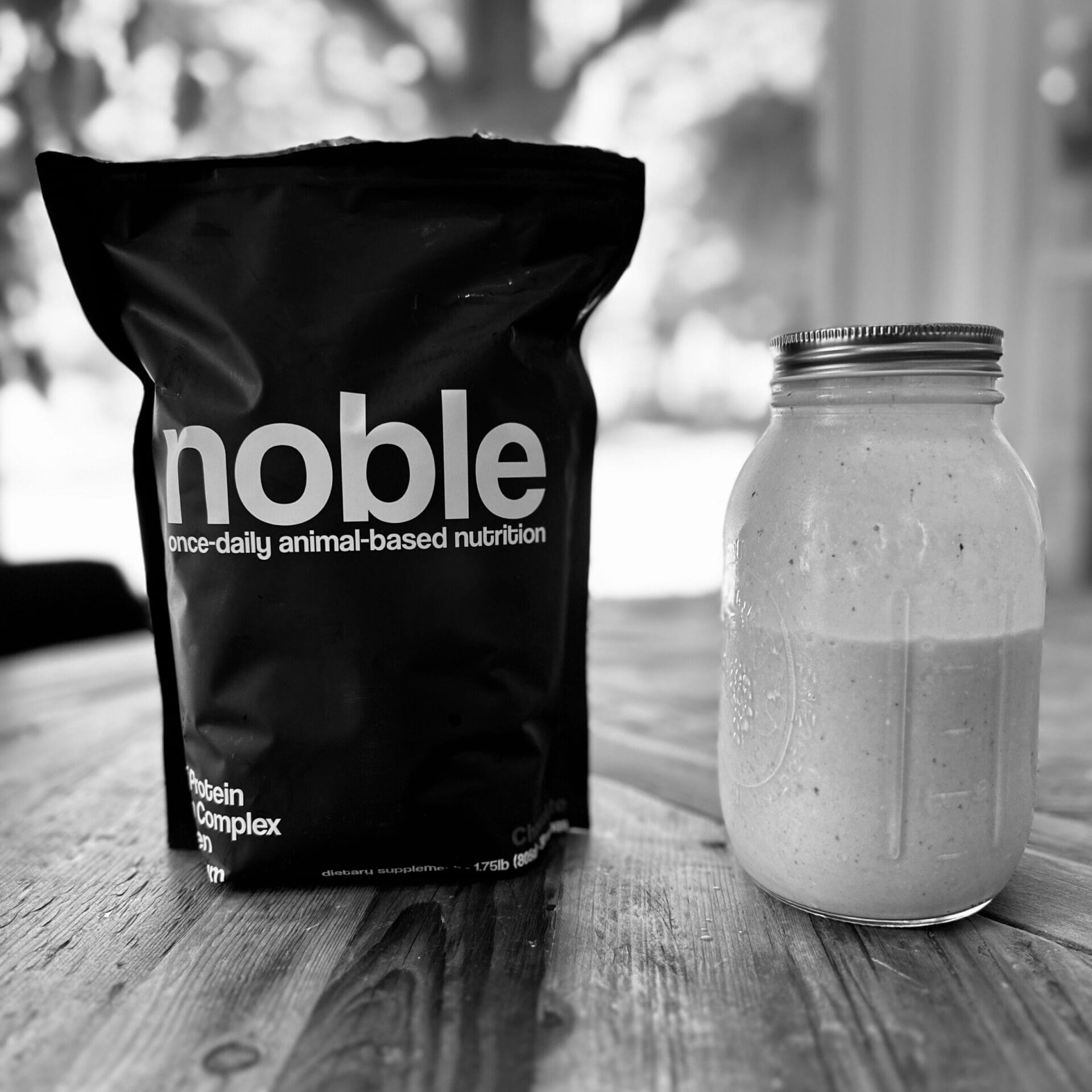
The two downsides of this otherwise outstanding protein powder are its price and the inclusion of xanthan gum to achieve excellent mixability and to avoid clumping. Small amounts of Xanthan gum aren’t problematic, but I’d accept some clumping in return for one less ingredient.
To make the price of Noble Beef Protein more palatable, you can sign up for a subscription (you can cancel anytime) and save 10%. Conversely, you can use promo code MICHAEL at checkout to get 15% off the purchase price.
Noble is also available on Amazon for the same price, but unfortunately, you won’t be able to use my discount code.
Best for a Keto Diet: Perfect Keto Whey Protein

What I like about Perfect Keto’s whey protein is that it includes whey protein isolate, which removes most carbs, including lactose (milk sugar) and other “impurities.” Additionally, this protein powder contains more fat than others, thanks to the 5 grams of added MCTs your body can use for energy (by converting them into ketones). The extra fat also helps you feel satiated for longer.
Note that this product’s natural flavors come from dehydrated cocoa and vanilla beans instead of synthetic flavors made in a lab.
| Cost per serving: | $2.20. |
| Protein per serving: | 15 grams. |
| Ingredients: | Grass-fed whey protein isolate, natural flavors (cocoa or vanilla), sea salt, stevia leaf extract, gum acacia and MCTs. |
| Notes: | Perfect Keto Whey Protein is available in two delicious flavors: chocolate and vanilla. |
If you’re not familiar with the term MCT, it stands for medium-chain triglycerides — a form of fat that the body can quickly convert into ketone bodies, the primary source of fuel if you’re on a low-carb high-fat diet.
My wife and I used to follow a relatively strict ketogenic diet before transitioning to an animal-based diet. During that period, we frequently purchased various supplements from Perfect Keto. Based on our experience, the brand offers some of the best-tasting keto products on the market. The company’s whey protein powder is no different — it’s delicious and mixes well with both hot and cold beverages.
I like the inclusion of MCT oil, which can help with energy production (your body can convert MCTs into ketones) and keep you satiated for longer. As a result, I’ll often have a scoop or two of Perfect Keto whey protein mixed with raw milk or kefir after exercise and when I don’t have time for a complete meal.
The downside is that each tub contains only 15 servings, and each serving costs $2.20 — slightly more than some of the other products in this article.
Make sure to use discount code michael20 to get 20% off your order.
Also Worth Considering: Primal Kitchen’s Primal Fuel Whey Protein
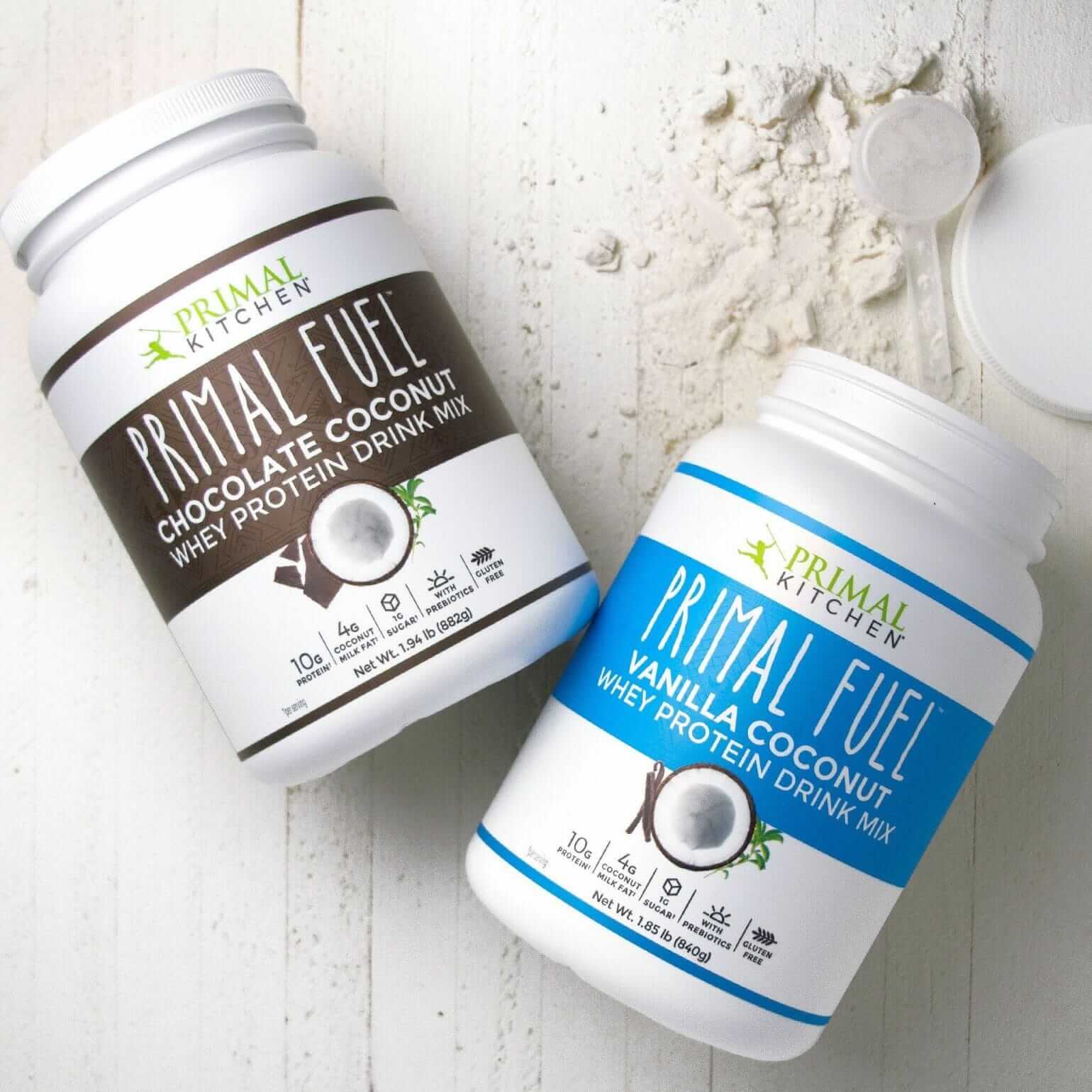
Primal Kitchen is one of our favorite brands because all their products are made with clean, high-quality ingredients compatible with paleo, keto or Whole30. Primal Fuel is no different; it’s a high-quality product with clean ingredients that tastes delicious.
Primal Fuel contains coconut milk powder, which increases the fat content of the mix. Plus, Primal Fuel uses natural flavors that are true to their name and don’t contain artificial ingredients or chemicals.
Each Primal Fuel Whey Protein tub contains 42 servings, each delivering 10 grams of protein. It retails for $49.95, but if you use code MK10, you get 10% off your order. (In other words, it’s about half the price of Perfect Keto.)
Make sure to use discount code MK10 to get 10% off your order.
Alternative Protein Sources for Special Dietary Needs or Preferences
If you’re allergic or sensitive to beef or dairy, or follow a plant-based diet, the following products are worth your consideration.
Goat Protein: Naked Nutrition’s Naked Goat
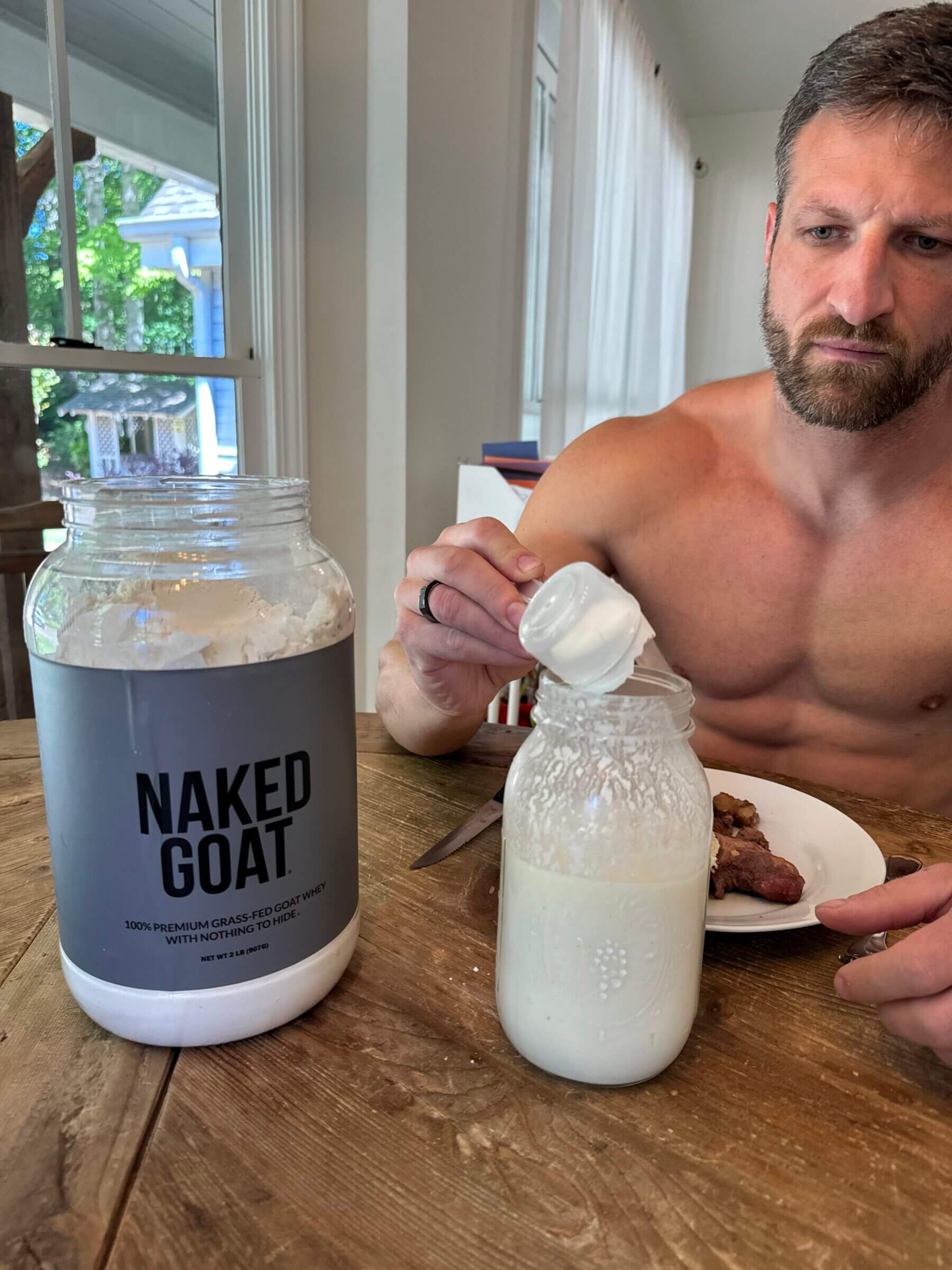
Goat protein has several advantages over beef or whey protein.
First, it’s generally easier to digest due to smaller fat globules and a different protein structure, making it a good option for those with sensitive stomachs or lactose intolerance. Goat milk protein also has a higher content of certain amino acids, like cysteine and taurine, which are beneficial for immune support and antioxidant functions. And it’s less allergenic than cow’s milk protein, reducing the risk of allergic reactions for some people.
The best goat protein powder on the market is Naked Goat from Naked Nutrition because it contains only one ingredient: cold-processed goat whey protein sourced from pasture-raised goats at small-herd Wisconsin dairies.
In other words, the product is free of additives, fillers, and flow agents that your gut might respond to sensitively.
The primary disadvantage of Naked Goat is its relatively high price of $69.99 ($2.33 per serving).
Naked Goat has no flavor and mixes well with hot or cold liquids. That’s why I like to mix it with raw milk kefir on days I don’t want to mask the kefir’s flavor with a (flavored) protein powder.
You can also find Naked Goat Whey on Amazon.
Egg Protein: Blonyx’s Egg White Isolate
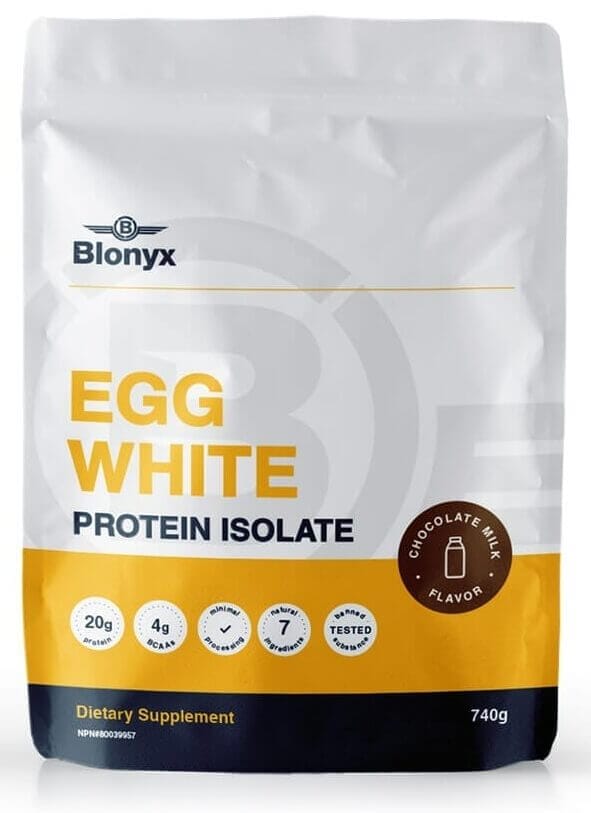
I love eggs because they’re an eggcellent source of protein, fat and micronutrients. In fact, we consume so many eggs that we raise 70 egg layers on our homestead to ensure a constant supply of pasture-raised eggs.
Interestingly, most people believe the egg white contains the most protein. The truth is that the yolk contains more protein (by weight), as well as most of the micronutrients. The egg white is merely a waste product that cushions the growing chick inside the eggshell.
Additionally, the egg white contains specific proteins — including ovalbumin (the most abundant), ovomucoid, ovotransferrin and lysozyme — that many people are sensitive or allergic to.
As a result, I would never consider consuming an egg white protein supplement. However, suppose you’re allergic to beef or dairy and are trying to avoid plant-based protein sources because of their poor bioavailability. In that case, Blonyx Egg White Isolate might be your best bet.
Usually, egg protein has a distinctive and unpleasant taste, which is why not many brands make it. However, the owner of Blonyx discovered a new processing method at an industry trade show that allows the company to carefully strip away impurities, leaving a neutral-tasting powder that contains only the protein.
If you look at Blonyx’s label carefully, you’ll see it contains 11 grams of organic cane sugar. That’s more (added) sugar than I eat in total on most days, and I wasn’t excited when I learned about it.
However, research shows how the body can take up glucose after an intensive workout without raising insulin levels. One study indicates that exercise-induced uptake could be caused by depletion of intracellular stores of carbohydrates (which makes sense, of course).
The bottom line is that the sugar in this egg white protein isolate might not cause an insulin spike if you take it after an intense workout.
Casein Protein: Naked Nutrition’s Naked Casein
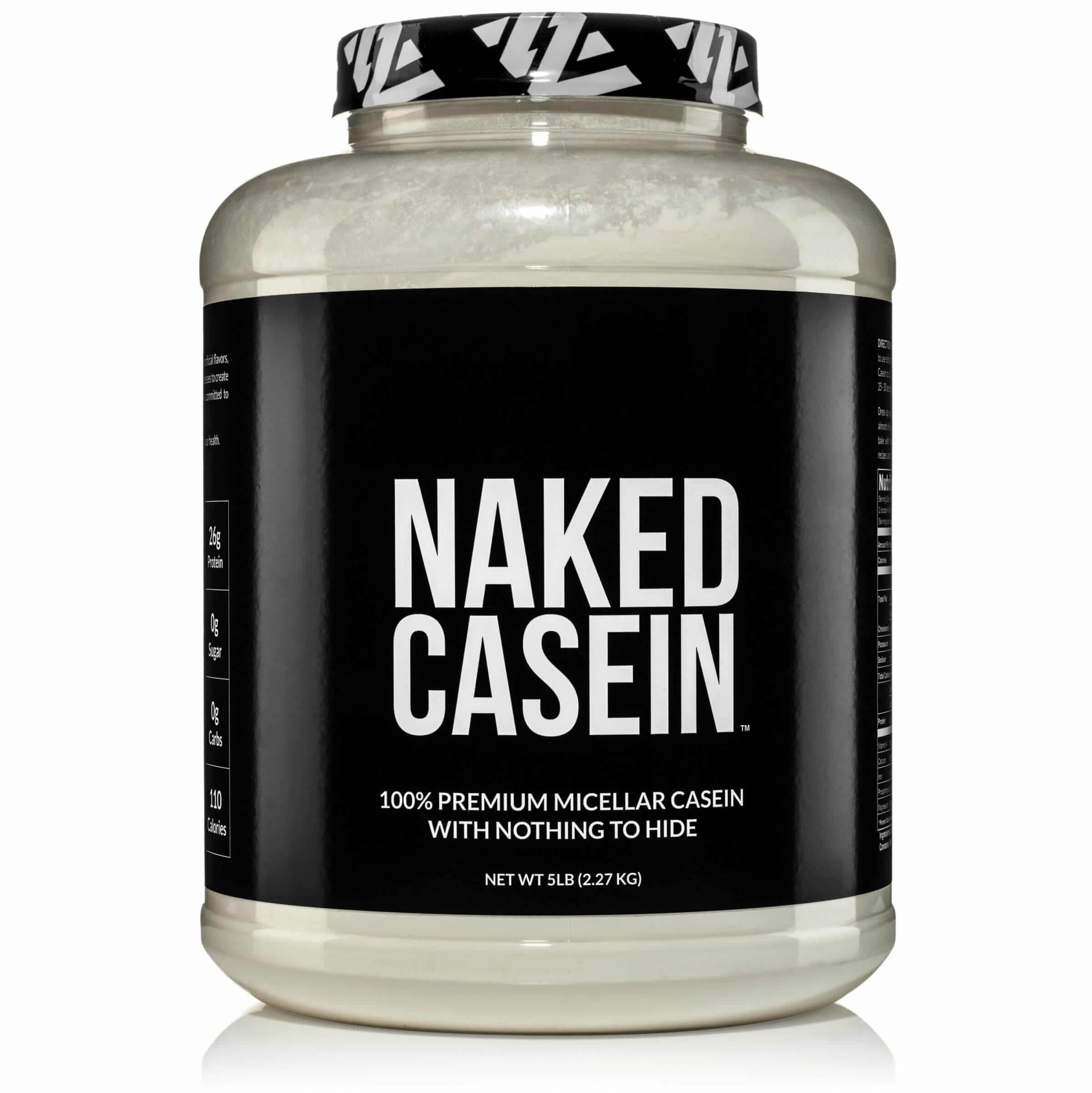
Like egg white, casein is a type of protein I would not consider supplementing with because of its potential to be inflammatory and irritating to the GI system. Casein is actually the second most common reason why people respond negatively to dairy products, behind lactose.
However, the advantage of casein is that your gut absorbs it more slowly than whey, leading some people to believe it’s the better choice to improve recovery after intense workouts (especially when consumed before bedtime).
Frankly, I don’t buy into the protein timing hype. But I suppose if you’re a professional athlete looking to exploit every opportunity to improve recovery by a few percent, consuming casein protein powder over alternatives might make sense.
If that’s you, I recommend Naked Casein because it has only one ingredient: carefully processed, unflavored micellar casein protein with an excellent amino acid profile.
The only negative comment I could make about Naked Casein is that Naked Nutrition did not source the protein from milk from grass-fed cows.
You can also find Naked Casein on Amazon.
Vegan: Isopure Nature’s Best Plant-Based Protein
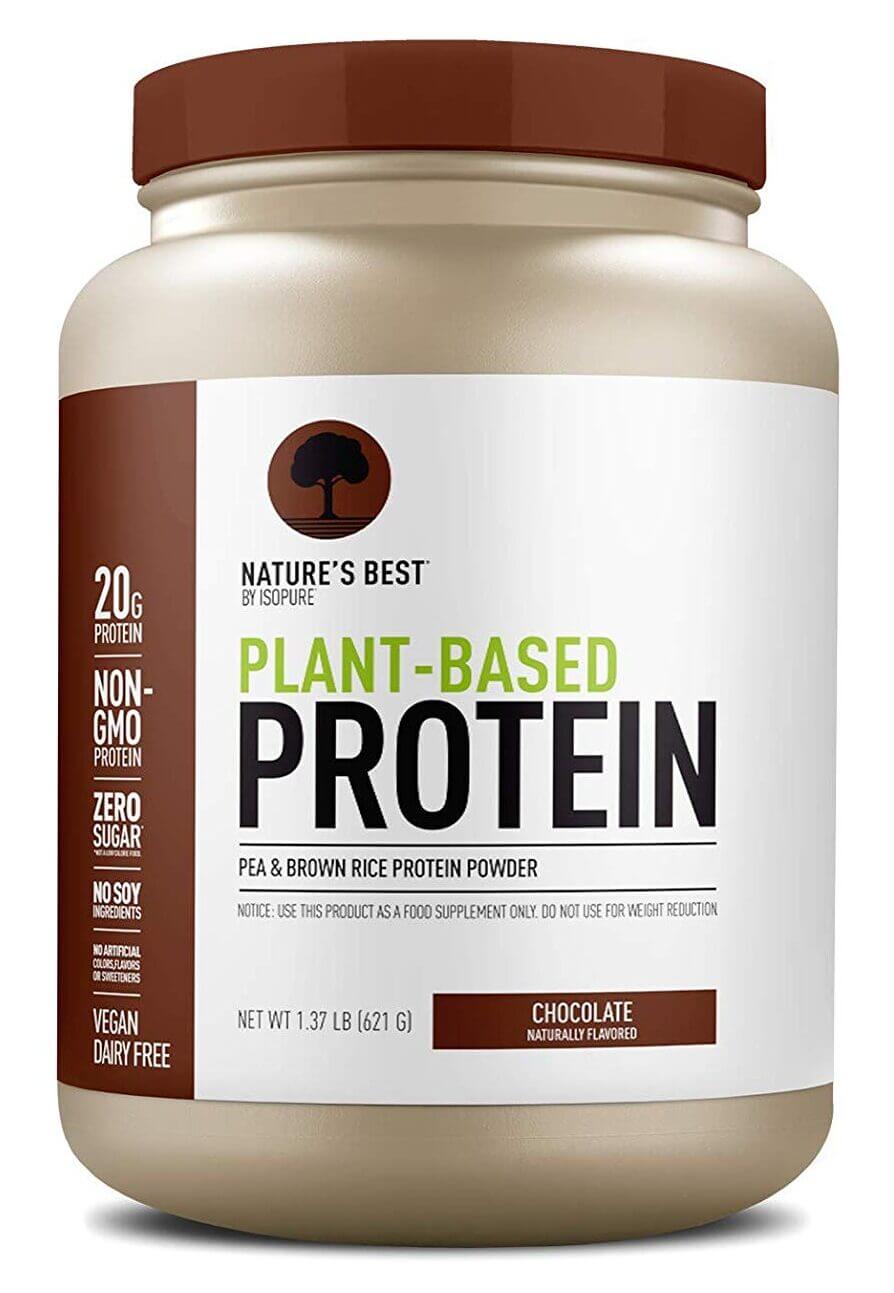
Getting all the essential amino acids from purely plant-based sources is challenging, especially in the realm of protein powders that contain only a single protein source (e.g., rice, pea or soy).
That’s why I like products that combine various protein sources. Nature’s Best plant-based protein is a high-quality blend of organic pea and rice protein. As a result, you get a reasonable mix of slow and intermediate-absorbing amino acids.
This protein powder is available plain or in chocolate or strawberry flavors, so you can mix it with water or your favorite nut milk (or even add it to a smoothie).
This non-GMO protein powder has only 2 grams of net carbs per serving, thus making it keto-friendly as well.
Note that clean protein powders typically do not provide much in the way of calories, and that’s especially true for vegan protein powders. If you need something more substantive, check out my list of the best vegan replacement drinks for a list of reasonably-healthy products.
Whey Protein Concentrate vs. Isolate (What You Need to Know)
There is significant confusion around the differences between whey protein isolate and concentrate, with many people believing that the former is a higher-quality product. However, the truth is more complicated than that.
Whey protein concentrate is actually more nutritious than isolate because it retains more of the beneficial nutrients and bioactive compounds found in whey. In other words, it’s less processed and provides a wider range of nutrients, including fats, carbohydrates, vitamins, and minerals. These additional components can offer various health benefits beyond muscle protein synthesis, such as immune support.
Whey protein isolate, while higher in protein content and lower in carbs and fats, is more refined and stripped of some of the beneficial compounds found in concentrate. It’s ideal for those who need a high-protein, low-carb, and low-fat supplement, or those with lactose intolerance.
I prefer whey protein isolate because, scoop for scoop, it has more protein than concentrate and I’m not too worried about missing out on micronutrients (which I get from drinking raw milk and consuming freeze-dried beef organs daily).
Final Thoughts: The Best Protein Powders Have Minimal Ingredients and No Junk
The protein powder market is flooded with cheap and unhealthy supplements, making it challenging to find a clean and effective product. You certainly aren’t going to get one by walking into GNC and grabbing a random bottle off the shelf.
While this round-up doesn’t cover every product I’d feel comfortable consuming myself or giving to my children, I hope it provides a framework that helps you pick the right protein powder for your needs and dietary preferences.
If you’d like to share your favorite protein powder or if you want my opinion on a product you’re considering buying, leave a comment below!

Michael Kummer is a healthy living enthusiast and CrossFit athlete whose goal is to help people achieve optimal health by bridging the gap between ancestral living and the demands of modern society.
Medical Disclaimer
The information shared on this blog is for educational purposes only, is not a substitute for the advice of medical doctors or registered dieticians (which we are not) and should not be used to prevent, diagnose, or treat any condition. Consult with a physician before starting a fitness regimen, adding supplements to your diet, or making other changes that may affect your medications, treatment plan or overall health. MichaelKummer.com and its owner MK Media Group, LLC are not liable for how you use and implement the information shared here, which is based on the opinions of the authors formed after engaging in personal use and research. We recommend products, services, or programs and are sometimes compensated for doing so as affiliates. Please read our Terms and Conditions for further information, including our privacy policy.


What are your thoughts on consuming whey protein with creatine as with B. Rad? Do you recommend taking them separately so that creatine is taken before to maximize efforts and then a separate whey protein after? I would like to try B.Rad but I am not sure if it’s most effective to take both before or after a workout.
Hey A,
There is nothing wrong with combining protein with creatine. However, if you want to work out fasted (like I do), consuming protein before a workout won’t work. The combination can also limit how much protein powder you can consume (if you’re sensitive to creatine). Those are the only downsides I can think of.